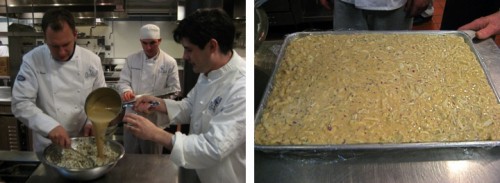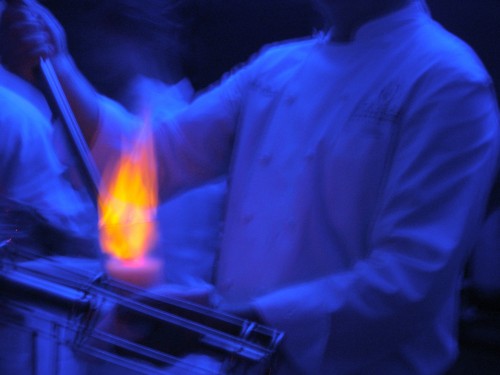Posted by Mindy Lvoff
Purpose: Demonstration of how to use technology to improve and expand your dishes
Techniques: Vacuum-infusion, Distillation (rotovap), Carbonation, Hydrocolloids, Hot Pokerage…
For the February Nils & Dave demo for student and alumni at The FCI, we decided that the theme should be: delicious food… and drink… using technology. Any demo that Nils and Dave do is centered around one main theme: using technology to enhance and improve food vs. (mis)using it to create gimmicky dishes, which is Nils and Dave Pet Peeve #1.
At this demo, we served four courses and, of course, a cocktail that encompassed several different technologies that we frequently use . The first appetizer course that we revamped was Crab Cakes & Fries. Instead of the dense cake that everyone is used to, we made crab bisque, melted in gelatin sheets, then folded in lump crabmeat and tiny dices of red onion. We put the whole thing in a plastic-lined sheet tray and let it set in the fridge. After, we sliced 1†thick pieces, breaded and fried them, and heated them through in an oven to melt the gelatin. The result was a crisp, golden “crab cake†that yielded hot, decadent crab bisque when bitten into.
The crab cake was served with Salt & Vinegar fries… I’m sure you know where this is leading. The potatoes were cut, vacuum-infused with white vinegar, par-cooked in cider vinegar, air-dried, then deep-fried twice to crispy perfection. Seasoned generously with salt, these fries were just plain addictive. For anyone who loves salt and vinegar chips or malt vinegar on your fries, eating these is like living the dream. These fries alone will make you want to buy your own vacuum machine.
The next appetizer (why have one when you can have two?) was a Hamachi Tartare. It was delicious, but the star was the blood orange reduction that dressed the dish. Forget reducing blood orange juice over the stove. Why destroy the flavor when instead, you can distill it under vacuum using heat so low that it never cooks off any of the fresh, tart flavors. It takes a while to distill out the water from the juice, but the result is a vivid orange-red reduction that tastes like Superman compressing all the flavor of a full blood orange in the palm of his hand and popping out a diamond-sized and quality bite (too geeky?).
For the main dish, Nils served up Kombu Duck Breast with Fried Japanese Eggplant. Each duck breast was wrapped in kombu , rolled up into a tube (Nils and tubes are like peas and carrots), then vacuumed down to infuse overnight. The next day, he sous-vided the duck for an hour at 57°C, then chilled it. At the demo, the skin on the duck breasts was seared to a perfect golden brown and served with a salad of the cooked kombu from the duck and frisée. Oh, and we just happened to have some of our roto-vapped port syrup lying around, so everyone got to enjoy a little with their duck—it basically ruined regular duck breast with a port sauce for the audience forever. The spongy Japanese eggplant were salted and vacuumed down to compress out all of the air so that when we fried it, it wouldn’t soak up its weight in oil. Breaded, deep-fried, and salted, these tender little bites tasted like delicious eggplant, didn’t ooze hot oil when you bit into them, and weren’t soggy at all. Cooks compress eggplant between sheets of paper towels using weights all the time, but using a vacuum is much easier and is done in a fraction of the time.
Â
We have a question: who doesn’t love pumpernickel toast, a little cheese, and some apple slices? It’s a trick question, the answer is no one. Even better than the traditional is to take those elements and create a phenomenal dessert with them of pumpernickel ice cream with Gjetost and curried apples. We literally mixed up pumpernickel bread and crème anglaise base (that we made in a vacuum bag in an 82°C circulated water bath two days earlier) in a Vita-Prep. Sometimes, as in this case, great ideas come to Nils and Dave at the last minute, meaning that we didn’t have enough time to freeze our ice cream the conventional way. Luckily, we just happen to own a dewar of liquid nitrogen, which helped us freeze down ice cream base in under 3 minutes. Once frozen, we turned to our other ice cream timesaver, the Pacojet. Once you freeze your cream base in one of its custom containers, you can pop it into the machine where a blade spinning at 2,000 rpm shaves a 2 micron-thin layer with each revolution. It yields a liter of smooth ice cream in less than 4 minutes. Voila, ice cream from start-to-finish in about 10 minutes.
Our vibrant and translucent curry-flavored yellow apple cubes were achieved using vacuum infusion. The curried apples paired nicely with the caramel-yogurt flavor of the thin slices of Gjetost cheese laid gently on top. And that ridiculously quick and easy pumpernickel ice cream… Maybe I’m a freak for caraway (potentially just a freak), but if I could eat this ice cream everyday I would.
Don’t leave just yet—there’s still the cocktail. That’s basically what Dave & Nils say at the end of every demo that they ever do. Truly, they are the mortal enemies of my liver. Luckily for the audience at this demo, we served up L’École’s signature Red Hot Ale (Abbey Ale, Cognac, Orange Bitters, Lemon Juice, Simple Syrup) using three incarnations of the Red Hot Poker: the original copper-head, the first portable incoloy poker, and the bar-friendly Red Hot Poker 2009. We had to dunk the copper one in water first to shake off debris, which meant racking off the final drink and no impressive flames. The beta and 2009 incoloy pokers resulted in impressive flames, but the beta version almost burned a hole through the chinois + pot holder that we rested it on. Only the custom-built 2009 Red Hot Poker allowed us to keep pumping out drink after delicious drink for the audience… many of whom stayed for a second round.






Please tell us more about the Red Hot Ale and the development of the Red Hot Poker 2009.
Hi – so happy that you’re reading and interested! We are actually going to put up a full post on the Red Hot Poker soon.
How does the blood orange reduction work?
The blood orange reduction is made in a rotary evaporator (rotovap), which distills the water off of the fresh juice under vacuum at or near room temperature. I can’t remember off the top of my head how many mls of reduction we get per liter of juice (in reality we do it by eye). There is a recipe for the reduction as well as a (very) lengthy explanation of the rotary evaporation proccess in our primer section.
Thanks for reading,
Dave
the hydrocolloid class was great – thanks guys
Thank you!
Dave
Just reading tonight (06.07) and am enamored with the writing and substance of this blog. Before I got here i was still very much lost w/o a herd. Kudos and please keep up the good work.